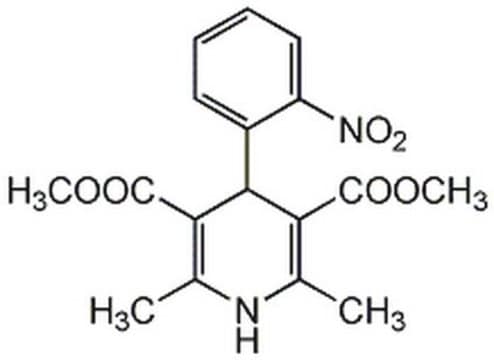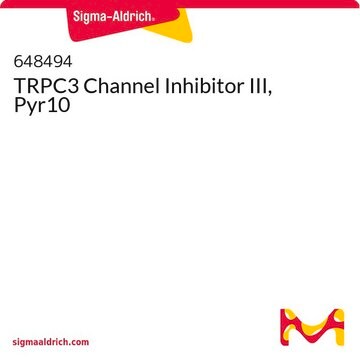SML1243
Pyr10
≥98% (HPLC)
Synonym(s):
N-[4-[3,5-Bis(trifluoromethyl)-1H-pyrazol-1-yl]phenyl]-4-methyl-benzenesulfonamide
Sign Into View Organizational & Contract Pricing
All Photos(1)
About This Item
Empirical Formula (Hill Notation):
C18H13F6N3O2S
CAS Number:
Molecular Weight:
449.37
UNSPSC Code:
12352200
NACRES:
NA.77
Recommended Products
Quality Level
Assay
≥98% (HPLC)
form
powder
color
white to beige
solubility
DMSO: 20 mg/mL, clear
storage temp.
2-8°C
Biochem/physiol Actions
Pyr10 is a novel, selective inhibitor of the transient receptor potential channel TRPC3. Pyr10 blocks carbachol-induced calcium entry into TRPC3-transfected HEK293 cells (IC50 = 0.72 μM), with significantly lower activity against STIM1/Orai1 mediated release of calcium from endoplasmic reticulum (store operated calcium entry) in BRL-2H3 cells (IC50 = 13.08 μM).
Storage Class Code
11 - Combustible Solids
WGK
WGK 3
Flash Point(F)
Not applicable
Flash Point(C)
Not applicable
Certificates of Analysis (COA)
Search for Certificates of Analysis (COA) by entering the products Lot/Batch Number. Lot and Batch Numbers can be found on a product’s label following the words ‘Lot’ or ‘Batch’.
Already Own This Product?
Find documentation for the products that you have recently purchased in the Document Library.
Samuel Shin et al.
International immunopharmacology, 117, 109853-109853 (2023-02-25)
Renal tubular epithelial cells are capable of synthesizing interleukins (IL) in response to a variety of proinflammatory cytokines. Moreover, elevated urinary levels of IL have been shown in patients with various forms of nephritic diseases. However, the underlying intracellular signaling
Samuel Shin et al.
Cellular signalling, 67, 109484-109484 (2019-11-27)
Oxidative stress and reactive oxygen species (ROS) generation can be influenced by G-protein coupled receptor (GPCR)-mediated regulation of intracellular Ca2+ ([Ca2+]i) signaling. ROS production are much higher in proximal tubular (PT) cells; in addition, the lack of antioxidants enhances the
Our team of scientists has experience in all areas of research including Life Science, Material Science, Chemical Synthesis, Chromatography, Analytical and many others.
Contact Technical Service








